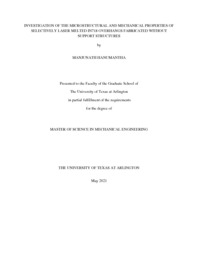
ATTENTION: The works hosted here are being migrated to a new repository that will consolidate resources, improve discoverability, and better show UTA's research impact on the global community. We will update authors as the migration progresses. Please see MavMatrix for more information.
Show simple item record
| dc.contributor.advisor | AMERINATANZI, AMIRHESAM | |
| dc.contributor.advisor | KUMAR, RATAN | |
| dc.creator | Hanumantha, Manjunath | |
| dc.date.accessioned | 2022-07-14T18:13:12Z | |
| dc.date.available | 2022-07-14T18:13:12Z | |
| dc.date.created | 2021-05 | |
| dc.date.issued | 2021-05-07 | |
| dc.date.submitted | May 2021 | |
| dc.identifier.uri | http://hdl.handle.net/10106/30717 | |
| dc.description.abstract | Additive manufacturing is a new manufacturing technology that allows for extreme design freedom as well as the simultaneous production of many parts with high complexities. IN718 is a high-strength, corrosion-resistant super alloy of nickel and chromium. It is ideal for high-end applications such as rocket nozzles and turbines because it can handle exceptionally high pressure and heat. Because of its high stiffness qualities, conventional manufacturing of complex IN718 geometries is challenging. Various fabrication techniques have been developed, and this study focuses on selective laser melting (SLM) because of its potential to produce near-perfect parts at a low cost when working with a variety of different materials. As a result, selective laser melting (SLM) provides a viable solution for the high-accuracy fabrication of IN718 components. One of the drawbacks of this technique is the need for supports to fabricate overhanging structures. These supports must be carefully planned and appear to consume a significant number of resources. Because of the superalloy's high toughness and job hardening, machinability of IN718 is extremely difficult, requiring the use of additive manufacturing, specifically SLM.
The fabrication of complex geometries is difficult without the proper allocation of support to overhang and angled structures for the component, which holds the component intact and maintains structural stability during manufacturing. Multiple properties of SLM components, such as microstructural structure, mechanical properties, stiffness, and toughness, are either directly or indirectly influenced by the allocation of support to overhang and angled geometry.
This research focuses on angled structures made without supports. The overhangs were created with standard process parameters for varying thicknesses. Variations in melt pools and Vickers hardness were determined using microstructural analysis and hardness tests. The results of this study will help us in predicting the need for supports in overhangs and inclined structures used within a complex geometry component. | |
| dc.format.mimetype | application/pdf | |
| dc.language.iso | en_US | |
| dc.subject | Additive manufacturing | |
| dc.subject | 3D printing | |
| dc.subject | Metal 3D printing | |
| dc.subject | Inconel718 | |
| dc.subject | SLM process | |
| dc.subject | Mechanical properties | |
| dc.subject | Vickers hardness | |
| dc.subject | Overhangs | |
| dc.subject | SEM | |
| dc.subject | XRD | |
| dc.subject | EDS | |
| dc.subject | Microstructure | |
| dc.subject | Melt pool | |
| dc.title | INVESTIGATION OF THE MICROSTRUCTURAL AND MECHANICAL PROPERTIES OF SELECTIVELY LASER MELTED IN718 OVERHANGS FABRICATED WITHOUT SUPPORT STRUCTURES | |
| dc.type | Thesis | |
| dc.degree.department | Mechanical and Aerospace Engineering | |
| dc.degree.name | Master of Science in Mechanical Engineering | |
| dc.date.updated | 2022-07-14T18:13:12Z | |
| thesis.degree.department | Mechanical and Aerospace Engineering | |
| thesis.degree.grantor | The University of Texas at Arlington | |
| thesis.degree.level | Masters | |
| thesis.degree.name | Master of Science in Mechanical Engineering | |
| dc.type.material | text | |
Files in this item
- Name:
- HANUMANTHA-THESIS-2021.pdf
- Size:
- 2.377Mb
- Format:
- PDF
This item appears in the following Collection(s)
Show simple item record


